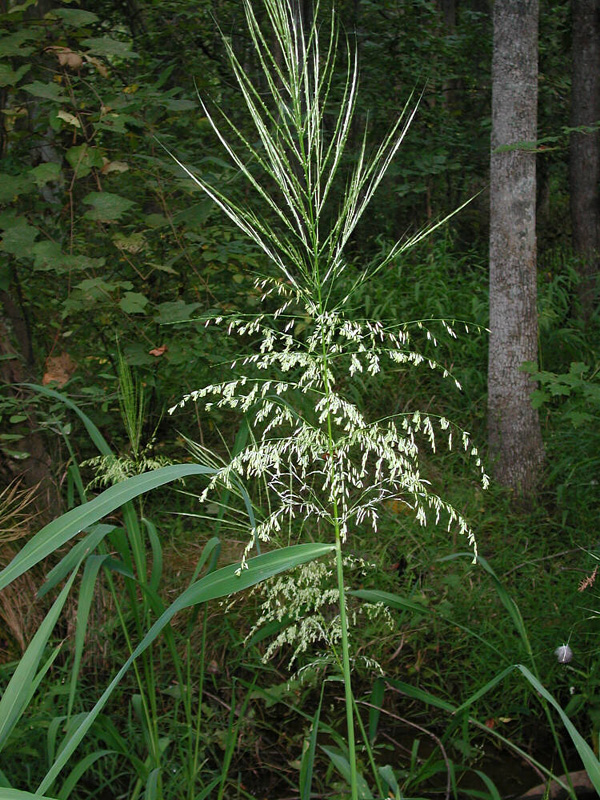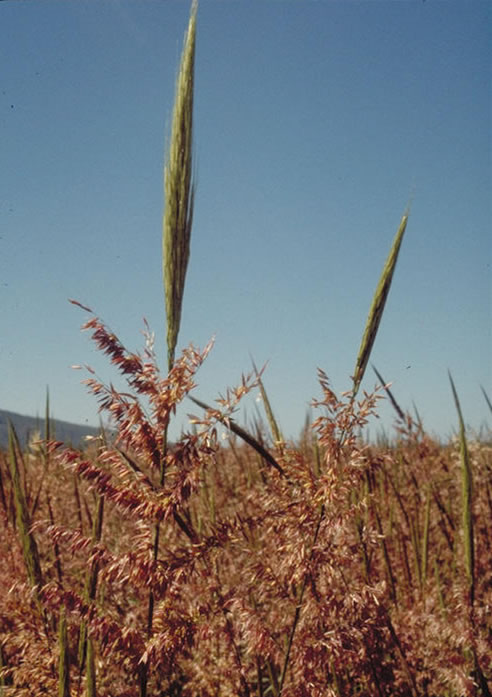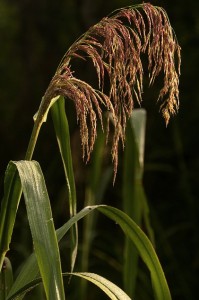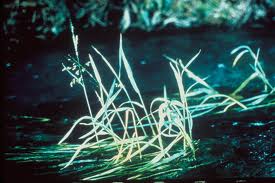Love and marriage, horse and carriage, Zizania and canoe… not exactly lyrical but you get the idea. If you want Wild Rice you have to go where the Wild Rice is, and that’s in water, not greatly deep water, but water nonetheless. Emergent is the word.
Truth be known Wild Rice, Zizania aquatica, is not rice and often not wild particularly if you buy it in a store. But those are quibbling points. It’s a popular and delicious grass grain, fairly easy to collect — if you know the technique — and nutritious as well. It was the staple of many Native America tribes, particularly in northern climates. They fought wars over it. Wild Rice is one of my favorite wild foods though locally we are on the very end of its range.
There are at least three species of Zizania maybe four. Botanists argue over that (think of it as a swamp turf war.) Z. aquatica is along the Atlantic Coastal plain from right here — Central Florida — to the northeast end of North America. From that same northeast land’s end west and southwest along the Great Lakes one finds Zizania palustris (which is either a separate species or a variation of Z. aquatica.) Both of those are annuals. Zizania texana is found only in Hays County, Texas, in the San Marcos River area, and is a perennial. There’s also a perennial Wild Rice in Japan, Taiwan, China and much of eastern Eurasia called Zizania latifolia. Incidently the latter becomes infected with Ustilago esculenta which causes the lower stem to swell. The Chinese parboil the stem then saute it with meat or other vegetables.
Locally the object de forage is Zizania aquatica, see top photo, not to be confused with Zizaniopsis miliacea, Giant Cut Grass, left, which also grows here. Z. aquatica is a very large grass to ten feet tall. Its stems are thick and spongy. Leaves are strap-like up to four feet long and two inches wide, smooth. The leaf’s edge is sharply toothed. The inflorescence is erect, very large up to two feet long and a foot across with spreading branches. The lower branchlets (male) droop, upper branchlets (female) are stiff and upright. Numerous spikelets and flowers, grain ovoid, yellow to reddish, up to an inch long. The flower is the quick key to separating the Zizania from the Zizaniopsis which resembles Wild Rice. The entire inflorescence — male and female parts — droop on the Zizaniopsis. The female parts of the flower on Wild Rice are stiff and point up.
Several first foragers use the Zizania species. Captain John Smith of Pocahontas fame said of the Wild Rice that it “groweth as our bents do in meadows…. seed is not much unlike rye, though much smaller… this they use for dainty bread buttered with dear suet.” Most folks don’t realize that Smith was a close friend of the king’s gardener and was in North America to basically find plants. His prowess with the barely pubertic Pocahontas seems to have captured historical fame more than his penchants for pokeweed. Smith was a swashbuckling kind of guy and probably the most famous of men who share his common name. He’s the first among John Smiths and was going to be executed when the ship he was on landed. However, papers labeled ‘only open in North America’ put him in charge of everyone including the captain who was going to execute him. That has to be the world’s sweetest reprieve. The “bent” he was referring to is probably some speices of Agrostis.
As for the Wild Rice, the Menominee, who take their name from the plant in Ojibwan, manoomin, cooked the grain with deer broth, pork, or butter and seasoned it with maple syrup. The Ojibwa used it to make muffins as well as stuffing for duck and other birds. They steamed it to fluff it up and had it for breakfast with sugar and cream. Popping it was common. And… prepare yourself for this… No, I really mean it. Steel thyself, ’cause this ain’t pretty: TheOjibwa also boiled it with rabbit excrement and considered the concoction a delicious luxury. Other tribes that consumed the grain included the Dakota, Meskwaki, Omaha, Ponca, Thompson, and Winnebago.
Several early writers mentioned how the grain was harvested with the use of two sticks and a canoe. Basically the plant is leaned over the canoe with one stick and brushed with the other. After parching some tribes trod on the grain to winnow it. Not the best method as even just a little grit makes the grain difficult to consume. Sand is not an edible. Incidentally, the Zizaniopsis miliacea has edible seeds as well and the growing tips of its white rhizomes are edible cooked . Zizaniopsis means looks like Zizania. Miliacea is millet-like.
Aquatica means in the water, palustris means in the swamp, texana in Texas and latifolia wide leaf. Zizania is a bit more involved. It’s from the Greek word ζιζάνια (zee-ZAH- nee-ah) or singular in modern Greek ζιζάνιο (zee-ZAH-nee-oh.) It was a weed that inflitrated wheat fields. In Dead Latin it is said zye-ZAY-nee-ah. The word in modern Greek also means dissension or a mischievous person or tare (said tear which is a vetch.) Linguistically you have a choice: You can use Dead Latin and say zye-ZAY-nee-ah or use Living Greek and call it zee-ZAH-nee-ah. I’ve made my choice…
Nutrionally Wild Rice is about 77% carbohydrates and between 15 and 17% protein. The grains are rich in glutelins and essential amino acids, especially lysine and methionine. It is a good source of B vitamins and is low in amylose, only 2%.
Green Deane’s “Itemized” Plant Profile: Wild Rice
IDENTIFICATION: Zizania aquatica: Annual, erect, aquatic grass to ten feet. Stems hollow; leaves flat, to four feet long, two inches wide, leaf-markings purple with thick midrib often nearer one leaf side than the other. Flowers cross-fertilized and wind-pollinated, large, open, terminal panicles, two-feet long a foot wide. Male flowers on lower portion of the flower droop; female parts of the flowers are stiff and erect, twisted barbed awns; kernels (seed) closely adhering to thin brown hull, shallow-grooved the entire length of one surface, long, nearly cylindrical, purplish-black when ripe. Roots slender, fibrous, penetrating shallowly.
TIME OF YEAR: Late summer, mid-August into mid-September. Grains are collected by using two sticks the length of your arm. One is used to bend the plant over the canoe. The other stick is used to gently brush the plant to knock off ripe seeds. Successive visits to the same plant are possible as not all the seeds ripen at the same time. Harvesting can start as early as after 4.5 months of growth. Grain is harvested when the plants are still green. If they are brown, you’re too late. Collected grains should be sun dried for at least a couple of days. An alternative is parching the grains which is heating them in an open pan, stiring until they are dry. Hull parched rice immedately or they will remoisten. Keep away from sand. A little grit goes a long ways.
ENVIRONMENT: Wild Rice is completely absent from strongly alkaline waters and avoids stagnant water. The current must not be perceptible but a constant change of water is desirable. Fresh water plant, not growing successfully in water with a salty taste, thrives in brackish water in low marshes bordering tidal rivers, and in no more than two feet of water, and where the annual change of water level is not more than two feet. Grows wild in shallow freshwater lakes and edges of lakes and streams. It requires slow-flowing water through the rice bed or field, with depth of water from one to four feet with constant or slightly declining water levels through the growing season. Raising water uproots the plant.
METHOD OF PREPARATION: Cleaned grains are usually boiled. They can also be popped or ground into a flour used with other flours or added to stews as a thickener.





